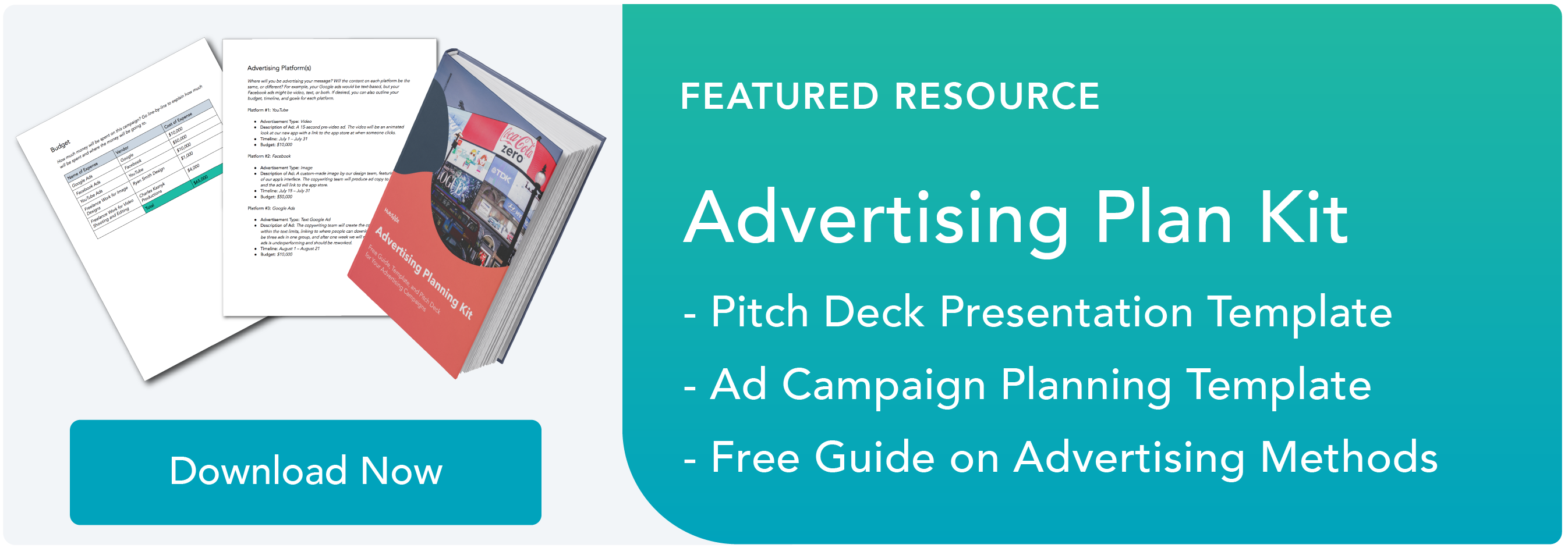It started out as a video-sharing social network where users shared short clips of themselves lip-synching and dancing to trending music. It has since expanded to house more diverse videos and become a creative outlet for brands.
After the merger, TikTok’s active user base grew by almost 800%. Today, the platform has over 1 billion monthly users and brands are using TikTok ads to reach them.
In this article, we’ll cover everything you need to know about TikTok’s advertising platform and discuss if it’s worth leveraging.
- Types of TikTok Ads
- How do Tiktok ads work?
- How to Set Up Your TikTok Account
- TikTok Ad Review Process
- TikTok Ad Examples
- TikTok Advertising Cost
- Should you leverage TikTok for Business?
- TikTok For Business Pros and Cons
The platform’s stated goal is to help businesses unleash their creative side by teaching them how to use the app through their e-learning service and guiding them through making advertisements on the Ads Manager platform.
The sole marketing format for businesses to use on TikTok is video advertisements. The TikTok For Business Ads Manager platform helps marketers create these advertisements, and they can choose from five different formats.
TopView Ads
TopView ads on TikTok are videos that appear once a day, immediately after a user opens their app for the first time. Here’s an example of a TopView ad by candy company M&M that they’ve created to advertise a virtual Halloween experience.
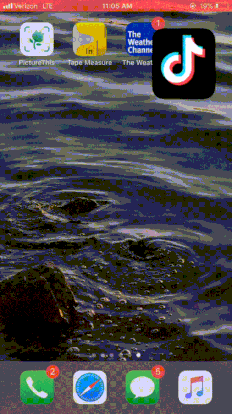
TopView ads can be up to 60 seconds long, which is longer than the typical run-time for TikTok videos. Because of this, it’s perfect for businesses looking to advertise products or services that require longer periods of attention, like TV trailers.
In-Feed Ads
In-Feed ads are videos that appear on a user’s discovery page, otherwise known as the “For You” page. This is where users land when they open the app. The For You page features videos that the TikTok algorithm believes are of interest to the user based on their app activity.
These ads are the fourth video users see as they scroll through their feed. For reference, this type of advertisement is similar to those that appear in a user’s Instagram feed. Here’s an example of an In-Feed ad created by food delivery service GrubHub.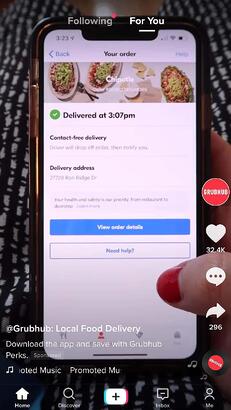
In-Feed ads are especially valuable for marketers looking to use TikTok to drive sales conversions, as the videos can feature a call-to-action (CTA). Acorns, a finance business, has used the In-Feed CTA feature to prompt viewers to download their app.
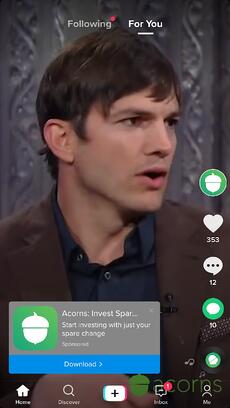
Some brands have created their own version of In-Feed ads by partnering directly with influencers. For example, Raising Cane’s Restaurant partnered with famous TikTok influencer Chase Hudson to promote their business.
this my way eating @raising.canes what’s yours #CaniacAmbassador #raisingcanes
Users who follow Hudson would see this video within their For You feed.
Branded Hashtags
Branded Hashtags are advertisements that businesses use to inspire TikTokers to create content around a brand-related hashtag of their choice. Businesses using this ad format have exclusive access to the hashtag, which is not the case on other social media sites. Its exclusivity comes along with a high price tag, and reported average costs are around $150,000 USD for six days.
For example, say you’re a sportswear company that has just launched a new athletic shirt called Blue Shirt. You may create a branded hashtag called #InMyBlueShirt, where you encourage TikTok users who have your product to post videos of them doing physical activities in the shirt.
Jennifer Lopez, a music artist, has used the Branded Hashtag feature to advertise her song, Pa Ti. The hashtag is called #PaTiChallenge, and Lopez posted a video of herself dancing where she encouraged other TikTok users to take part in the challenge by replicating her dance.
Let’s goooo! ✨🚨✨ Can’t wait to see and share some of your best #PaTiChallenge dances! Thanks for kicking it off @charlidamelio! @papijuancho
The #PaTiChallenge hashtag has garnered 2.4 Billion views.
Hashtag Challenges can be featured on TikTok’s Discover page, where users can find new creators and browse trending hashtags. The Discover page is similar to Instagram’s Explore page.
The hashtag challenge #WorldSeries, sponsored by Major League Baseball, is featured on TikTok’s Discover feed, and the hashtag encourages users to post videos showing how they’ve celebrated baseball games. Clicking on the hashtag brings users to an internal landing page that features the sponsors’ logo, challenge description, and other videos using the hashtag.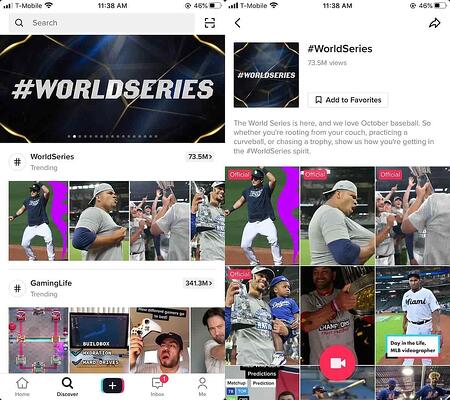
Brand Takeovers
Brand Takeovers are an ad format that can include TopView, In-Feed, and Branded Hashtags all at once. They can also be videos, gifs, or still images. The takeover aspect of these ads is that TikTok only features one business per day, and the starting cost is around $50,000 USD per day.
Guess, a fashion company, ran a Brand Takeover on TikTok to advertise their denim jeans. Over six days, their TikTok account gained over 12 thousand new followers and generated a 14.3% total engagement rate. Their Brand Takeover included Top View, Branded Hashtag, and In-Feed ads.
Branded Effects
Branded Effects ads use 2D, 3D, or AR to add images of your products into TikTok videos. Brands typically create stickers of their products or create filters that TikTokers can use when creating their videos. These filters and stickers increase engagement and brand awareness, as using them typically involve playing brand-specific games.
Puma, a clothing company, used the Branded Effects feature to advertise their new soccer shoes. Their 3D sticker prompted users to play a virtual reality game with a soccer ball. They paired their Branded Effects sticker with a hashtag challenge that generated over 100,000 videos of user-generated content.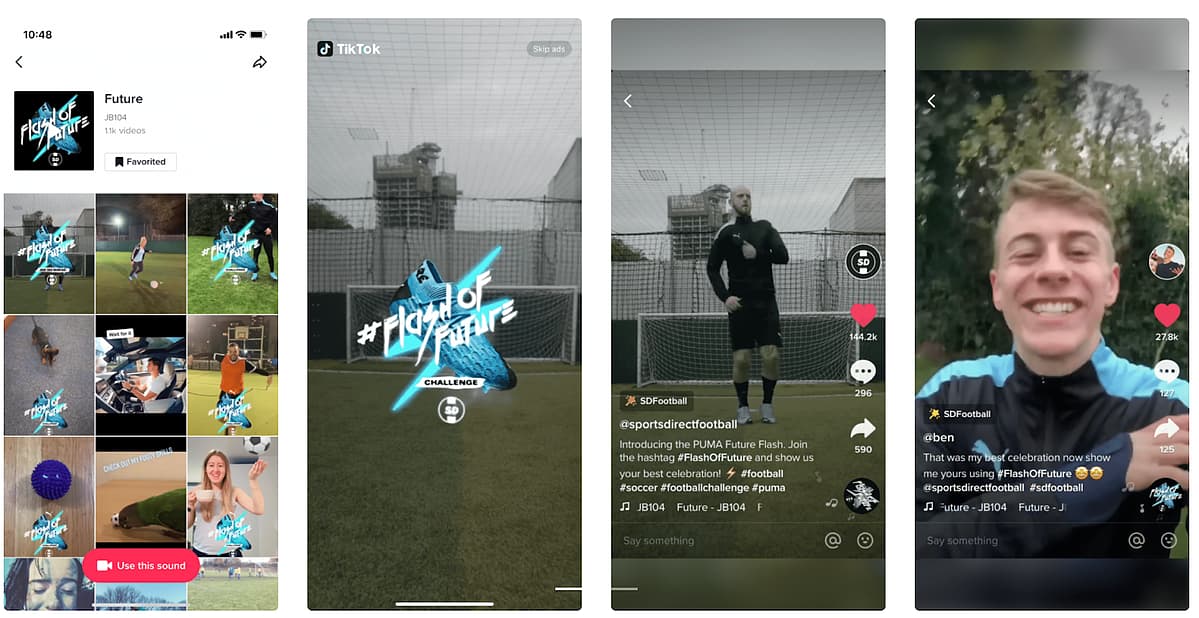
How do TikTok ads work?
Setting up a TikTok ad is relatively easy.
First, you have to create a business account from which you will build, manage, and track your ads. The next step is describing your business and setting up your payment type.
Now, here’s where the fun starts. You can choose between two ad manager modes: simplified and custom.
In both options, you build your ad in levels. You first outline your campaign, then define your ad group, and finally create your individual ads.
Here’s the difference between these two modes:
- Simplified mode takes a simple and straightforward approach to ad creation, letting Tiktok’s algorithm do the heavy lifting.
- Custom mode gives advertisers full control over their ads with advanced customization options, such as A/B testing, audience targeting based on video and creator interactions, and ad combinations.
Choosing a mode isn’t permanent, you can always switch to another mode.
Now that you know how TikTok ads work, here’s how to set up your account and build your ad.
-
Create a business account.

-
Describe your business.
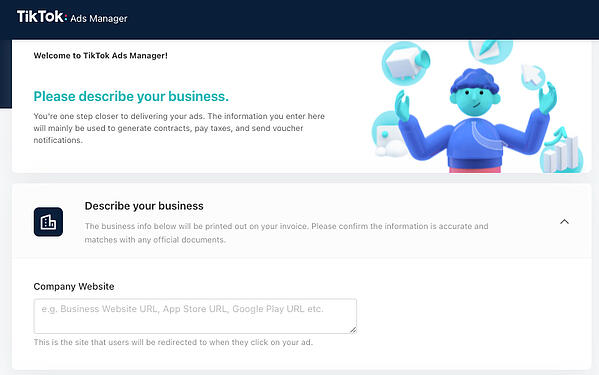
-
Enter your billing information.
![TikTok Ads Guide How They Work, Cost + The Review Process [+ Examples]](https://blog.hubspot.com/hs-fs/hubfs/Google Drive Integration/TikTok Ads Guide How They Work, Cost The Review Process [ Examples].png?width=500&name=TikTok Ads Guide How They Work, Cost The Review Process [ Examples].png)
-
Set up your payment type.

-
Select your ads manager mode.
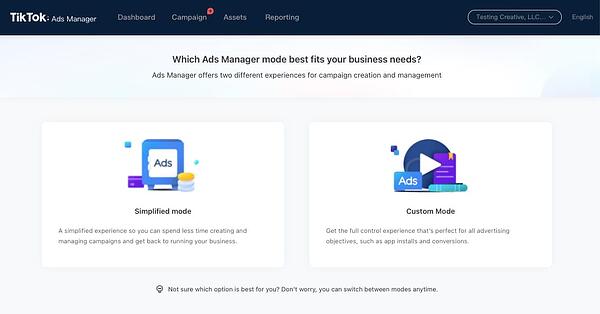
-
Build your ad.
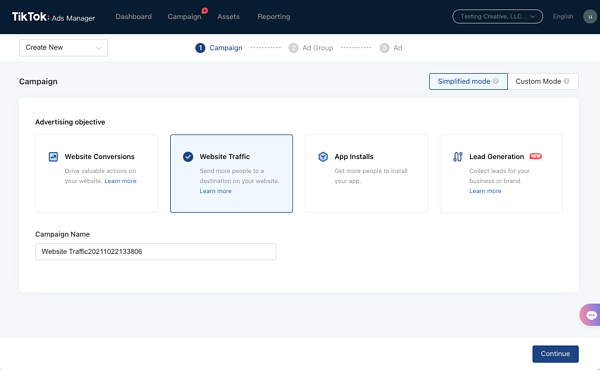
Pro-tip: When building your ad, consider Promo, the video marketing tool that allows you to find video templates and create high-quality promotional videos.
-
Review and submit.
TikTok Ad Review Process
When you submit an ad for review, it usually takes 24 hours to review. To avoid any delays, you want to make sure your ad meets the platform’s ad requirements and follows its policies.
Here’s a checklist to use when reviewing your ad before submission:
- The landing page:
- Is functional and mobile-friendly.
- Delivers on what it outlines in the ad.
- Matches the product name in the ad.
- Is in the language of the region it’s targeting.
- Doesn’t automatically download files to a user’s device.
- The ad:
- Is free of spelling and grammatical errors.
- Contains audio.
- Is between five to 60 seconds.
- Doesn’t include excessive use of symbols, spacing, numbers, or capitalization.
- Matches the caption.
- Is in the language of the region it’s targeting (or includes subtitles.)
- Doesn’t include any prohibited products or services. Find a full list here.
- Is not blurry or pixelized.
- Follows standard video sizes: 9:16, 1:1, 16:9.
TikTok Ad Examples
1. Fly By Jing
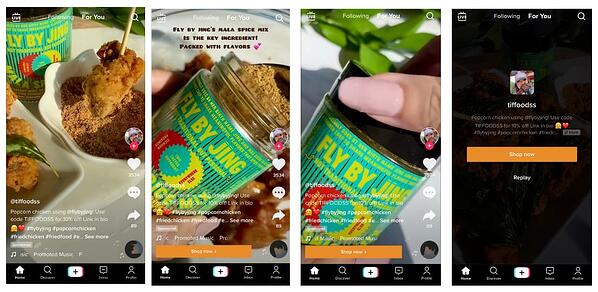
In this TikTok ad, food brand Fly By Jing partnered with food influencer TiffyCooks to demonstrate how easy (and tasty) it is to use the brand’s product.
Leveraging a known influencer is always a great way to raise awareness for your brand and build trust with your audience. Another great thing about this ad is that the offer is clear: Users can get 10% off by clicking on the CTA and using the code.
2. Tiffany & Co.
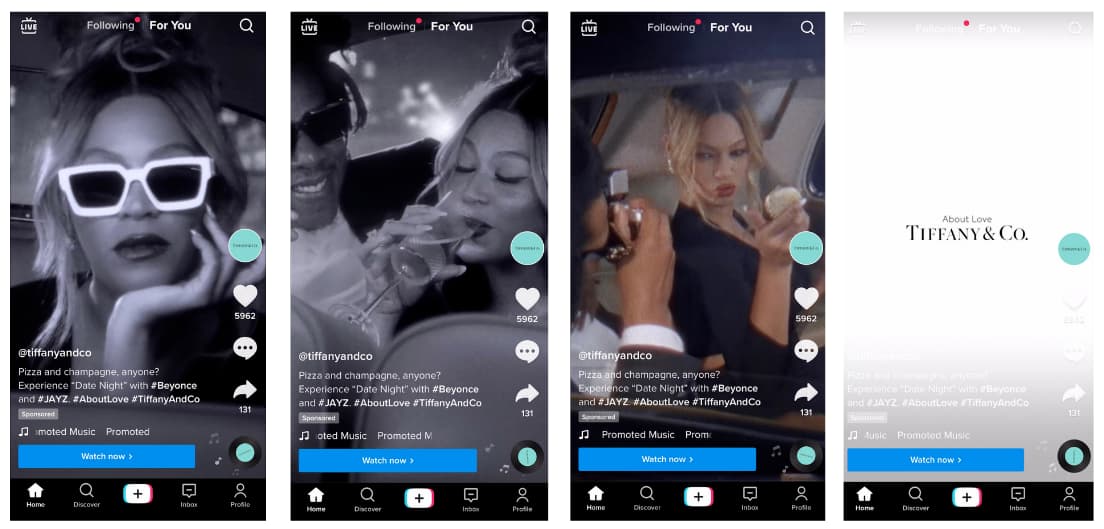
To promote its latest partnership with Beyoncé and Jay-Z, the brand has launched a series of ads including the artists.
The ad is simple, but effective and leads users to a landing page where they can learn more about the campaign.
3. Omsom
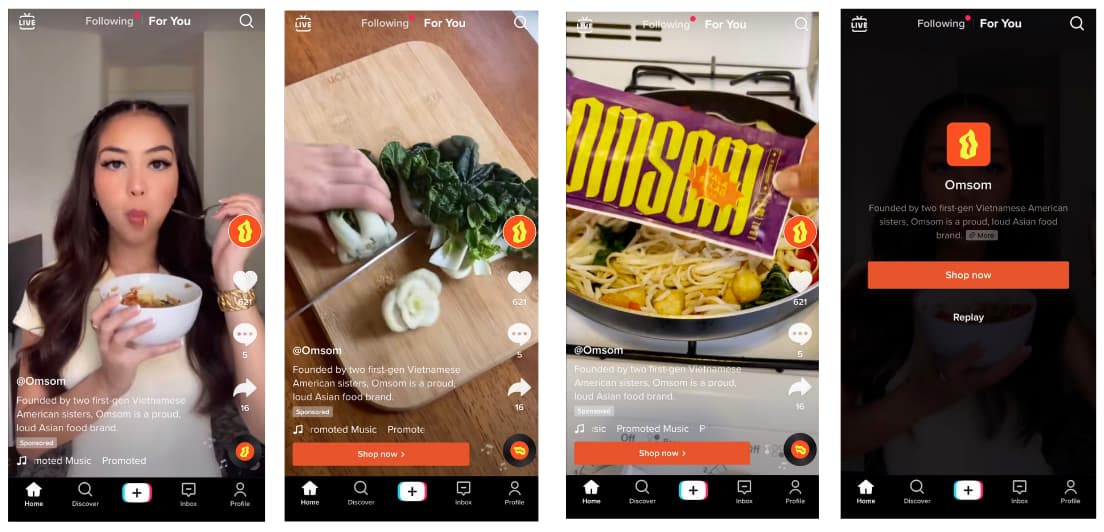
In 20 seconds, this food brand accomplishes a lot.
The video effectively showcases hows how its product is used. The caption also gives users some background on the brand and tells a story in just a few words. In addition, the CTA leads users right to a product page (instead of the homepage) where they convert.
Lastly, too often, ads seem jarring because they don’t fit the feel of the platform. That’s not the case here. The ad feels so natural in the feed that you wouldn’t know it was an ad if you removed the #sponsored tag and CTA.
TikTok Advertising Cost
When it comes to budgeting for Tiktok advertising, here’s the breakdown. You can select a daily or lifetime budget, which can be changed at any point during your campaign.
At the campaign level, you must have a minimum daily and total budget of $50 USD. For an ad group level, your budget must exceed $20 USD daily.
As for the advertising cost, TikTok hasn’t released its pricing policy. However, there is some information out there.
In 2020, Digiday reported that TikTok had a cost-per-mille as low as $1. After running their own experiment, JungleTopp reported that the cost-per-click was $0.19 – much lower than Facebook and Instagram.
With this platform, you can choose between several bidding strategies that are optimized for specific goals.
Should you leverage TikTok in your marketing strategy?
Since peaking in 2020, TikTok has become a go-to advertising platform for many brands. As the number of users increased, the number of ads they saw also followed from 19% in 2020 to 37% in 2021.
A 2021 Kantar report ranked the short-form video platform in the number one spot for ad equity, surpassing Amazon, Instagram, Google, and Twitter. This isn’t the first time either – they also held that spot the year prior.
Despite this impressive ranking, the data suggests marketers are still unsure about the platform. According to the report, many marketers view TikTok as highly innovative but not quite trustworthy.
As such, many prefer to rely on tried-and-true media platforms like Facebook, YouTube, and Instagram.
From a consumer perspective, consumers go to TikTok for authenticity and community.
According to a 2020 Nielsen study surveying global TikTok users, 59% of respondents said they feel a sense of community when they hop on the app. It’s also a major source of discovery for consumers, with 85% of users discovering new content they enjoy on the app.
As a result, the ads that are on the platform also tend to be more creative and a little less “commercial.” The study revealed that 68% of TikTok users globally find that the ads on the platform are unique and different from other social media platforms. In Indonesia, that figure goes up 23%.
So, the audience is there and ready to engage. However, the decision to use TikTok For Business in your marketing strategy ultimately comes down to your business goals and desired campaign outcomes.
To make the decision easier, we’ve compiled a list of pros and cons for marketers to use when making this decision.
TikTok For Business Pros and Cons
Pros |
Cons |
|
TikTok Ads Manager will help you expose your content to new audiences. The ‘similar audiences’ feature helps you select lookalike audiences that are similar to your target ones. TikTok has a reported 1 billion monthly users and is available in 155 different countries. If your brand is smaller or less well-known, this could bring significant awareness to new audiences. 25% of TikTok’s user base is between 10 and 19, and 22% are between 20 and 29. If your target audiences are of different age groups, you could gain exposure to a new type of customer. |
TikTok’s largest user base is not representative of all demographic groups. Since its primary user base is very young, the audiences that businesses market to on the platform may be significantly younger than the intended target audiences. Advertising on the app may require you to tap into a user base that may not understand the need for your product or service. |
|
TikTok thrives off of informal, ‘behind-the-scenes’ content. Authenticity matters to Generation Z, and they tend to shy away from the ‘ sales-to-drive’ leads marketing ads. If your brand or business typically creates sales-driven formal content, utilizing the platform can help you diversify your content types and display a new, creative side of your business. |
TikTok requires niche content. The type of content that TikTok calls for may not be in line with your brand mission. If you’re a more serious, sales-focused business, learning to adapt to the fun and exciting content required for TikTok versus just driving sales conversions may be a difficult skill to learn. |
|
TikTok has higher engagement rates than Instagram and Twitter. In 2019, TikTok’s average engagement rate at all follower levels was higher than both Instagram and Twitter. Small accounts with just 1,000 had an average engagement rate of 9.38% . Even if you’re a smaller brand just starting on TikTok, you’re guaranteed to have an engaging audience. |
TikTok For Business reporting tool can’t be integrated with other platforms. All marketers know that data is crucial to understanding the success of marketing campaigns. At the moment, it doesn’t seem as though the platform can integrate with your preferred insights tool. While the Ads Manager is convenient, it will require an additional step for collecting data that you can use to understand your campaign engagement and ROI. |
Should you choose to incorporate TikTok into your advertising strategy, it can be a valuable tool for growth. While the app does call for niche types of content, brands and businesses can diversify their strategy and advertise to a new audience.
Whatever your final decision is, TikTok For Business is available to those who want to harness the app’s advertising potential.
![]()

![→ Free Download: Social Media Calendar Template [Access Now]](https://i4lead.com/wp-content/uploads/2021/11/3e56e15d-47bd-46c9-a256-99fde52abfe7.png)

